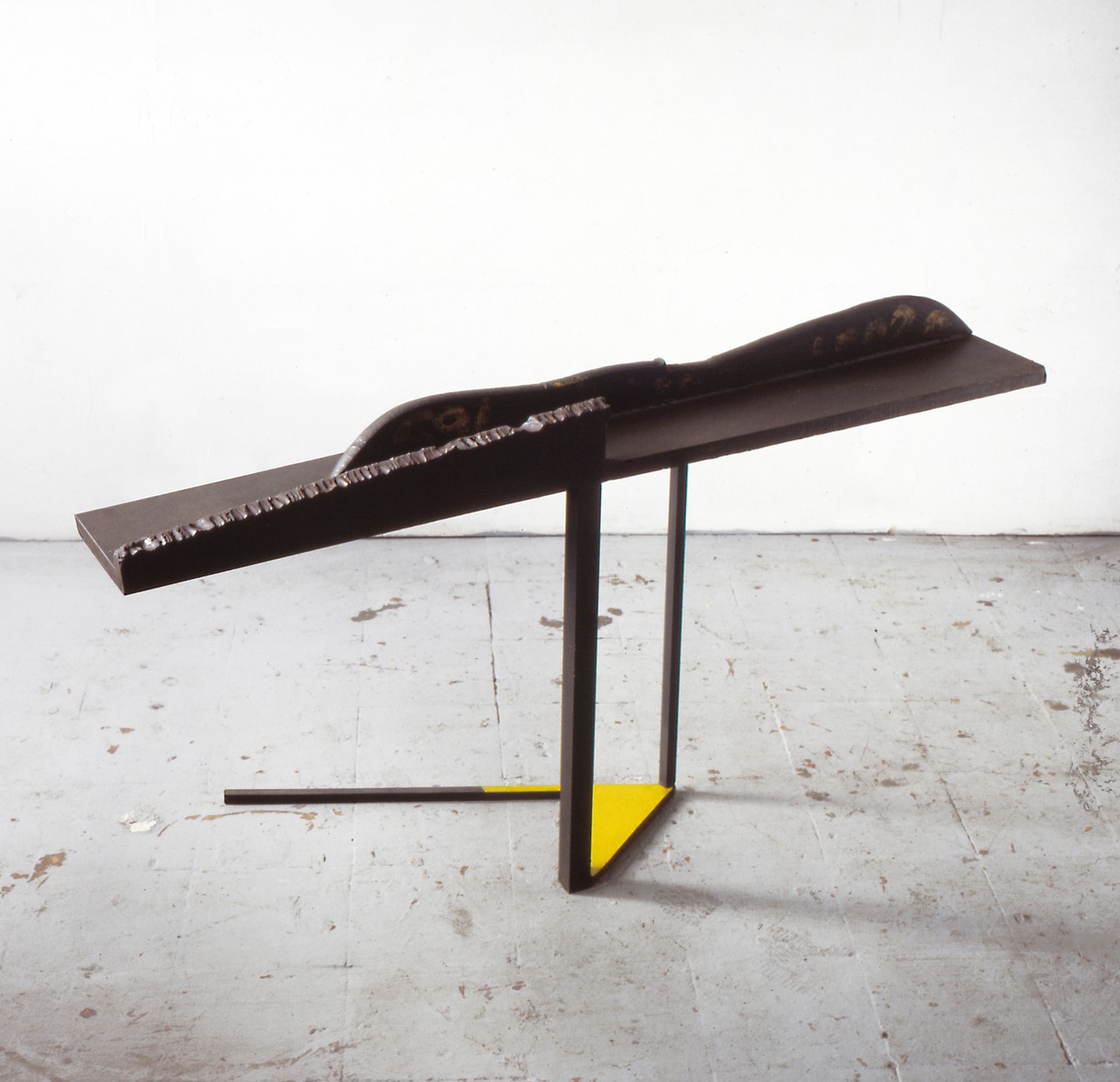Pello Irazu
10 Mar - 25 Jun 2017

The Land that Sleeps (La tierra que duerme), 1986
Steel and oil paint, 66 x 120 x 39 cm
Museo Nacional Centro de Arte Reina Sofía, Madrid. Long-term loan Collection Soledad Lorenzo, 2014
© VEGAP, Bilbao, 2017
Steel and oil paint, 66 x 120 x 39 cm
Museo Nacional Centro de Arte Reina Sofía, Madrid. Long-term loan Collection Soledad Lorenzo, 2014
© VEGAP, Bilbao, 2017
PELLO IRAZU
Panorama
10 March –25 June 2017
Curator: Lucía Agirre
Pello Irazu is a key figure in the renewal of contemporary Basque and Spanish sculpture. Over the course of three decades, he has forged a solid career by fusing the broadest possible spectrum of sculpture with photography, drawing, and mural painting.
Regardless of the discipline he uses, Irazu's work exhaustively explores the problems that arise in the multiple relations between our bodies, objects, images, and spaces.
The installation design hinges on a conceptual and physical device invented by the artist, which incorporates some of the most significant milestones and masterpieces of his career.
The Guggenheim Museum Bilbao is pleased to present Pello Irazu: Panorama, which examines the thirty-year track record of one of the foremost renovators of contemporary Basque and Spanish sculpture. As the title suggests, more than the backward glance which any retrospective entails, this show is a multi-directional vision where time wrinkles and folds in space, offering a kind of panoramic landscape.
The exhibition, featuring over one hundred works, hinges on a conceptual and physical device invented by the artist himself that incorporates some of the most significant milestones and masterpieces of his career. The aim is to create a kind of simultaneous perspective where past and future are reunited and refreshed in a continuous present. In the Museum, the walls of Gallery 105 help create an enveloping atmosphere that draws viewers to experience the work, making them part of it and inviting them to reflect on the language of sculpture.
A key figure on the contemporary art scene, Pello Irazu has forged a consistent body of work since the 1980s, alternating between broad-spectrum sculpture—from small-format three-dimensional creations to massive installations and hybrid objects—and photographs, drawings and mural paintings. In every medium he uses, Irazu's oeuvre exhaustively explores the problems that arise in the multiple relations between our bodies, objects, images, and spaces.
The backbone of this retrospective is a large corridor that cuts diagonally through the center of the space and divides it into different areas which are organized in a circular fashion. This layout proposes a complex spatial experience, where visitors will be free to choose between several more or less linear routes at any point along the way. The central corridor contains a chronological survey of Irazu's most important works on paper as well as a mural painted for the occasion that illustrates the evolution of his drawings, collages, and paintings, while the peripheral areas house his sculptures and photographs.
This artist's oeuvre runs the entire gamut of sizes—from diminutive sketches to large-format works—, and media—from pencil and watercolor to wallpaper, adhesive tape, and all sorts of prints—. The exhibition also allows visitors to discover different forms of artistic expression: figurative, geometric, documentary, gestural, etc.
Panorama
10 March –25 June 2017
Curator: Lucía Agirre
Pello Irazu is a key figure in the renewal of contemporary Basque and Spanish sculpture. Over the course of three decades, he has forged a solid career by fusing the broadest possible spectrum of sculpture with photography, drawing, and mural painting.
Regardless of the discipline he uses, Irazu's work exhaustively explores the problems that arise in the multiple relations between our bodies, objects, images, and spaces.
The installation design hinges on a conceptual and physical device invented by the artist, which incorporates some of the most significant milestones and masterpieces of his career.
The Guggenheim Museum Bilbao is pleased to present Pello Irazu: Panorama, which examines the thirty-year track record of one of the foremost renovators of contemporary Basque and Spanish sculpture. As the title suggests, more than the backward glance which any retrospective entails, this show is a multi-directional vision where time wrinkles and folds in space, offering a kind of panoramic landscape.
The exhibition, featuring over one hundred works, hinges on a conceptual and physical device invented by the artist himself that incorporates some of the most significant milestones and masterpieces of his career. The aim is to create a kind of simultaneous perspective where past and future are reunited and refreshed in a continuous present. In the Museum, the walls of Gallery 105 help create an enveloping atmosphere that draws viewers to experience the work, making them part of it and inviting them to reflect on the language of sculpture.
A key figure on the contemporary art scene, Pello Irazu has forged a consistent body of work since the 1980s, alternating between broad-spectrum sculpture—from small-format three-dimensional creations to massive installations and hybrid objects—and photographs, drawings and mural paintings. In every medium he uses, Irazu's oeuvre exhaustively explores the problems that arise in the multiple relations between our bodies, objects, images, and spaces.
The backbone of this retrospective is a large corridor that cuts diagonally through the center of the space and divides it into different areas which are organized in a circular fashion. This layout proposes a complex spatial experience, where visitors will be free to choose between several more or less linear routes at any point along the way. The central corridor contains a chronological survey of Irazu's most important works on paper as well as a mural painted for the occasion that illustrates the evolution of his drawings, collages, and paintings, while the peripheral areas house his sculptures and photographs.
This artist's oeuvre runs the entire gamut of sizes—from diminutive sketches to large-format works—, and media—from pencil and watercolor to wallpaper, adhesive tape, and all sorts of prints—. The exhibition also allows visitors to discover different forms of artistic expression: figurative, geometric, documentary, gestural, etc.
